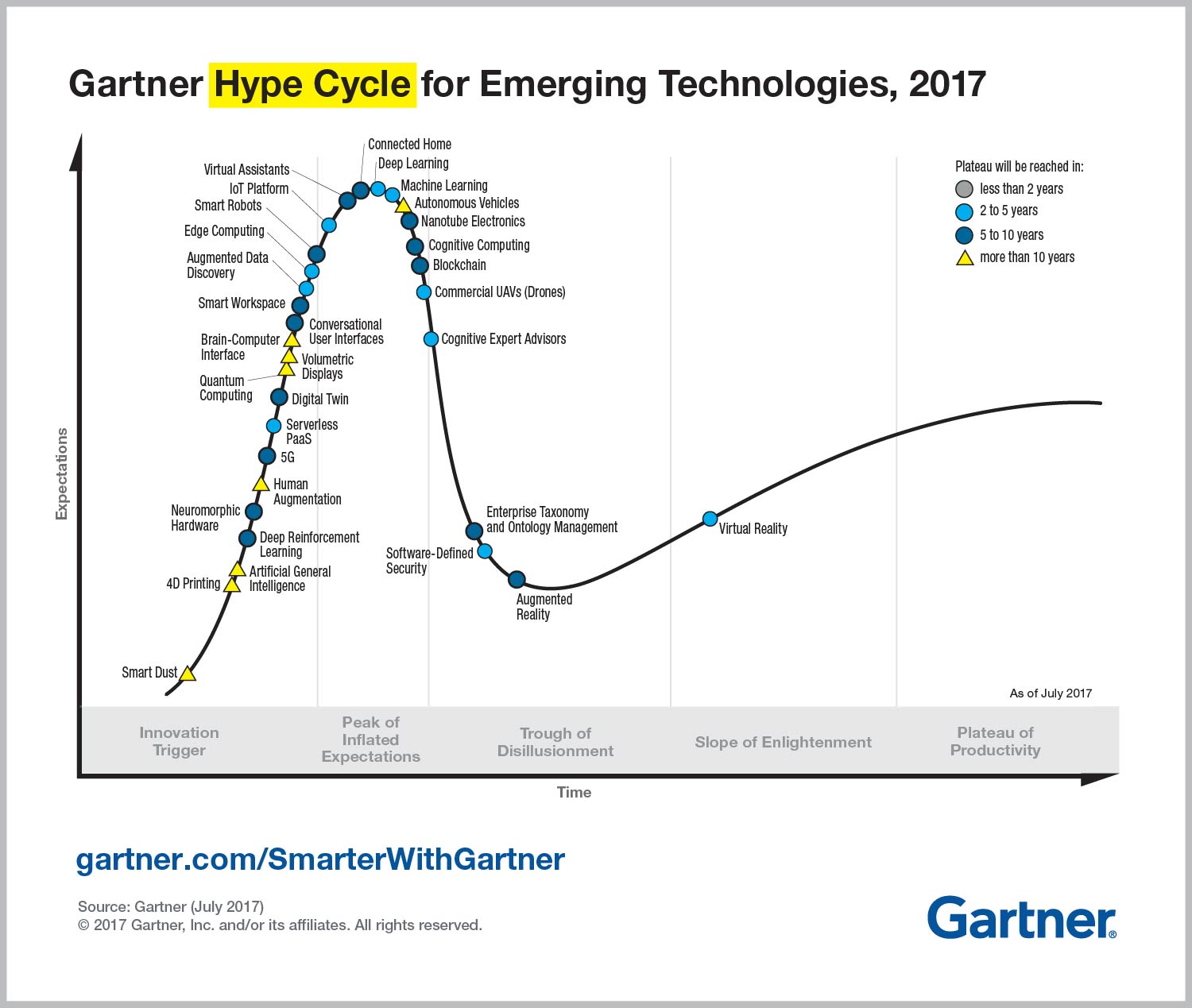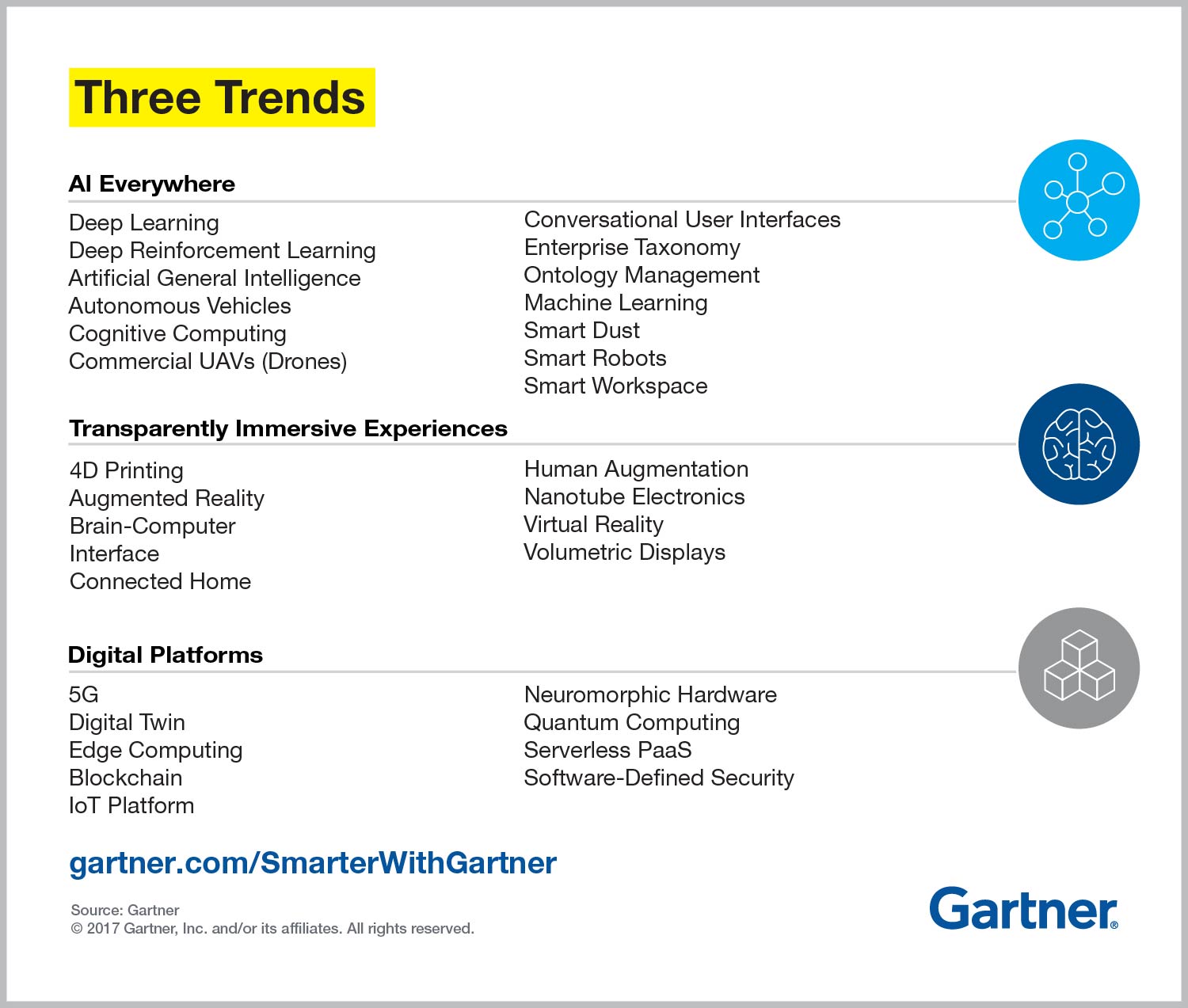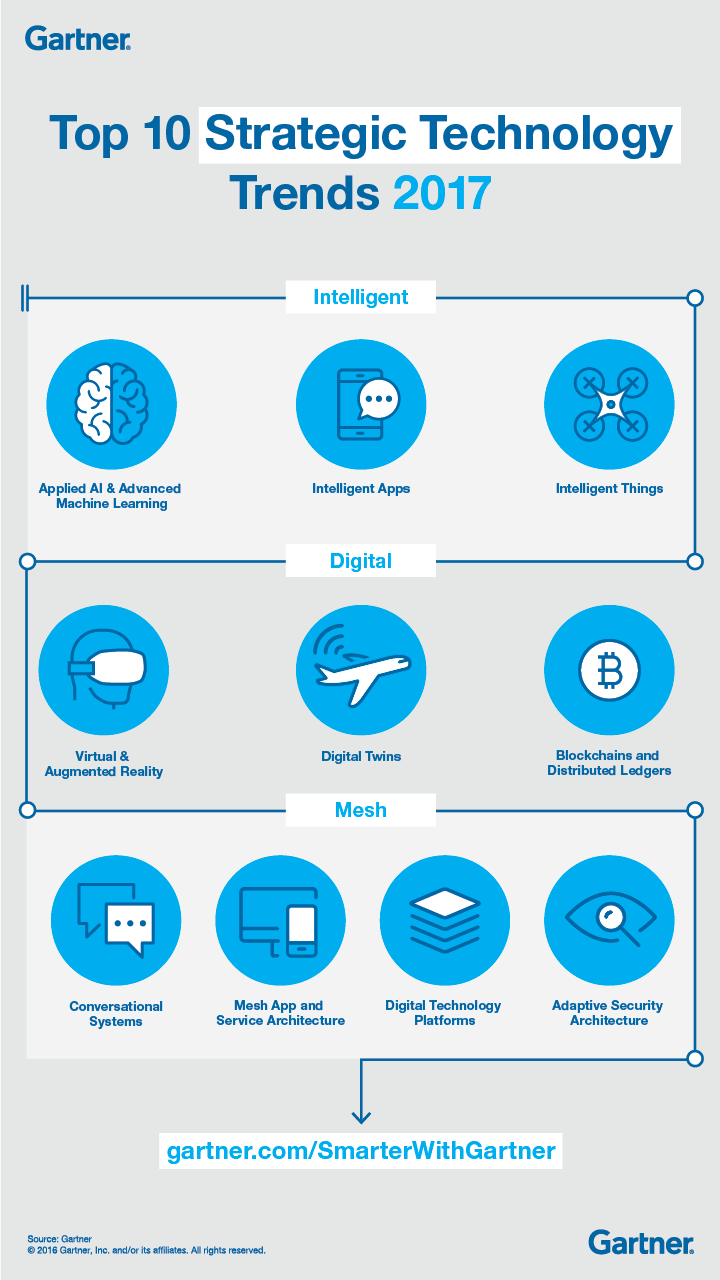Gartner Hype Cycle Emerging Technologies 2017
17. August 2017 13:40 Uhr | Dr. Ulrich Kampffmeyer | Permalink
Ausklingen der Sommerpause, heißer Herbst bei Gartner? Was auch immer. Diese Woche ist der aktuelle Hype Cycle von der Analystenfirma Gartner erschienen. Zusätzlich zum (1) aktuellen Ermerging Technologies Hype Cycle 2017 werfen wir den Blick zurück auf zwei andere Studien von Gartner, die die aktuellen Entwicklungen betreffen: (2) die Top Ten Technology Trends für 2017 und (3) den Magic Quadrant für Enterprise Information Archiving von 2016.
1. Gartner Hype Cycle for Emerging Technologies, 2017
Der aktuelle Gartner Hype Cycle erschien am 15.08.2017 (die Hype Cycle Infografik datiert bereits auf Juli 2017). Bei einem neuen Hype Cycle ist es natürlich immer wichtig, die Veränderungen zu den Vorjahren im Blick zu behalten (2016). Besonders Machine Learning, Blockchain, kommerzielle Dronen, Software-definierte Sicherheit und Gehirn-Computer-Interfaces haben sich im Vergleich zum Vorjahr schnell weiterentwickelt.
Schwerpunkte in 2017 sind entsprechend dem Bericht die Entwicklungen bei der Künstlichen Intelligenz. Insgesamt leitet Gartner drei Bündel von Trends ab:
<Zitat> The Gartner Hype Cycle for Emerging Technologies, 2017 focuses on three emerging technology mega-trends: Artificial intelligence(AI) everywhere, transparently immersive experiences and digital platforms.</Zitat>
Gartner schreibt hierzu:
<Zitat; Links und Quellen im Gartner Blog>
Artificial Intelligence (AI) Everywhere
Consider the potential impact of AI-enabled autonomous vehicles. They could reduce accidents, improve traffic, and even slow urbanization as people can use travel time and won’t need to live near city centers. “When autonomous vehicles, AI, IoT and other emerging technologies are combined with economic trends like the sharing economy, we truly see different business designs that profoundly disrupt the market,” Walker says. Uber is a prime example of how a business is fundamentally shifting an industry dominated by private vehicles to potentially upending the industry with transportation as a service. The media has been consumed with hype stories about autonomous vehicles, and it has led to inflated expectations for the technology. However, given that AI is critical for the technology, this has led to an increase in the development of machine learning algorithms. While continued advancements in sensing, imaging and mapping — as well as AI and computing — are helping to evolve the technology, the reality is that the complexity and cost requirements are presenting challenges. “AI technologies will be the most disruptive class of technologies over the next 10 years due to radical computational power, near-endless amounts of data and unprecedented advances in deep neural networks,” Walker says. “These will enable organizations with AI technologies to harness data in order to adapt to new situations and solve problems that no one has ever encountered previously.” Also in the realm of AI, machine learning, one of the hottest concepts in technology, has the potential to benefit industries from supply chain to drug research. It will soon become impossible for conventional engineering solutions to handle the increasing amounts of available data. Machine learning offers the ability to extract certain knowledge and patterns from a series of observations.
Transparently Immersive Experiences
At Facebook’s F8 Conference this year, the company introduced the Camera Effects Platform, launching a connection between augmented reality (AR) and social media. It ignited conversations about the potential for AR in the consumer world. However, the technology, which integrates virtual enhancements with real-world objects, could have big potential for industry. For example, instead of a relying on printed paper or separate screens, AR could overlay a maintenance schematic on a broken lamp post. Enterprises should create an AR strategy in the business with specific goals and tasks for trials and benchmarks. When it comes to transparently immersive experiences, technology is introducing transparency between people, businesses and things. As technology evolves to be more adaptive, contextual and fluid, it will become more human-centric. Besides AR, companies should look to digital workspaces, connected homes, virtual reality and 4D printing in this realm.
Digital Platforms
With bitcoin and Ethereum constantly in the news, blockchain might seem like it’s just around the corner. However, most initiatives are still in alpha or beta stage. Enterprises are still deciding how to navigate this technology, but the lack of proven use cases and the volatility of bitcoin have created concerns about the viability of the technology. Long-term, Gartner believes this technology will lead to a reformation of whole industries. Of the two types of blockchain — permissionless-public ledgers and permissioned-public ledgers — enterprises should look toward the latter option. Permissioned-public ledgers have access controls owned/managed by rules, but still allow for a community. For commercial transactions, companies might look to permissionless-public ledgers such as bitcoin, which allows unknown or untrusted users to access the ledger.
</Zitat>
2. Gartner’s Top 10 Strategic Technology Trends for 2017
Dies ist genaugenommen nur ein Rückblick, um die obigen Hype Cycle Entwicklungen gegen die strategischen Trends von Gartner zu spiegeln – denn diese stammen vom Oktober 2016 „Gartner’s Top 10 Strategic Technology Trends for 2017 „:). Diese Trends harmonieren sehr gut mit den Positionierungen im obigen Hype Cycle. Jedoch zeigt sich immer mehr die Beschleunigung der Entwicklungen und wie sie sich gegenseitig bedingen, verweben, überschneiden.
- Maschinenlernen umfasst fortschrittliche Systeme, die verstehen, lernen, voraussagen und möglicherweise selbstständig handeln. Die Systeme können zukünftiges Verhalten verändern und zu der Entwicklung von intelligenteren Geräten und Programmen beitragen. Ein Beispeil dafür sind die sensorischen Daten von Smartphones, mit denen Modelle für die Tendenz-zum-Kaufen entwickelt werden.
- Intelligente Apps: Indem intelligente Apps, wie der virtuelle persönliche Assistent, alltägliche Aufgaben vereinfachen, können sie den Arbeitsplatz umgestalten. Gartner erwartet, dass im Jahr 2018 die meisten der 200 größten Unternehmen intelligente Apps nutzen, um ihre Angebote und Kundenerlebnisse zu verbessern.
- Intelligente Dinge: Neue, intelligente Dinge fallen in drei Kategorien: Roboter, Dronen und autonome Fahrzeuge. Sobald diese intelligenten Dinge bekannter werden, werden sie sich in einer kollaborativen Intelligenz vereinen.
- Virtuelle Realität: Sie verändert die Art und Weise, wie Individuen ihren Alltag erleben und miteinander interagieren.
- Digitaler Zwilling: Innerhalb von drei bis fünf Jahren wird ein Großteil der Dinge einen digitalen Zwilling haben. Ein digitaler Zwilling benutzt Daten von Sensoren, um seinen Zustand zu verstehen, auf Veränderung zu reagieren und Werte zu verbessern. Ihr Aufstieg bringt eine kulturelle Umstrukturierung mit sich.
- Blockchain: Das ist eine Art von Konto, in dem Transaktionen in Blocks gruppiert sind. Mögliche Veränderungen würden vor allem das Verteilen, Identifizieren und Registrieren von Musik betreffen. Jedoch ist Bitcoin der einzige genehmigte Blockchain bislang.
- Vernetzte Systeme: Heutzutage kann die technologische Kommunikation von einfachen, zweidimensionalen Konversationen, wie zum Beispiel „Wie viel Uhr ist es“ zu komplexeren Interaktionen reichen. Neumodische Systeme machen es möglich, mehrere Eigenschaften zu nutzen, um über das Gerät zu kommunizieren.
- Vernetzte Apps: Das intelligente, digitale Netz fordert eine Veränderungen der Technologie und Instrumente, die für Lösungen benutzt werden. Die derzeitige Lösung ist eine Konstruktion, die viele User in vielen Rollen mit vielen Geräten unterstützt. Nichtsdestotrotz muss das digitale Business noch verbesserte Lösungsvorschläge entwickeln.
- Digitale Technologie Plattformen: Digitale Technologie Plattformen sind die Grundlage für Digital Business. Jedes Unternehmen wird einen Mix aus fünf verschiedenen, digitalen Technologie Plattformen gebrauchen: Informative Systeme, Kundenerfahrungen, Analytics, das Internet der Dinge und ein Business Ökosystem.
- Adaptive Sicherheitsarchitektur: Der Aufstieg von Digitalen Technologie Plattformen macht Sicherheit adaptiv. Besonders die Sicherheit im Internet der Dinge ist eine Herausforderung.
3. Gartner Magic Quadrant for Enterprise Information Archiving, 2016
Noche in Rückblick – bereits im Jahr 2015 hatten wir darauf hingewiesen, dass EIA Enterprise Information Archiving nichts mit dem deutschen Begriff der Elektronischen Archivierung zu tun hat. So verwundert es auch nicht, dass in dem Report Gartner MG Enterprise Information Archiving 2016 Anbieter auftauchen, die wir unter revisionssicherer Archivierung nicht erwarten würden. Es geht um Datensicherung von E-Mails,Social-Media-Inhalten und anderen Dateien. Hier machen sich immer mehr Cloud-Angebote breit. Und mit der Cloud dringen die Anbieter auch verstärkt in das Revier der traditionellen, Dokument-orientierten Archivierung vor.
In dem Magic Quadrant EIA_2016 (Dezember 2016) geht es um folgende Funktionalität (Markt-Definition):
<Zitat> This Magic Quadrant evaluates the vision and ability to execute of vendors focused on compliance, discovery and reference use cases for archive data. I&O leaders can use this research to identify vendors that provide archiving for email, social media, IM, files and other content types. The weighting for criteria was adjusted in this year’s Magic Quadrant, resulting in more movement among vendors‘ „dot“ placements that has normally occurred in past revisions. Please see the Evaluation Criteria section to view the criteria weightings.
Enterprise information archiving (EIA) incorporates products and solutions for archiving user messaging content (such as email, IM, and public and business social media data) and other data types (such as data stored in enterprise file synchronization and sharing [EFFS], Microsoft SharePoint documents, files, website content, and some structured data). A vast majority of market spend for EIA is for email compliance and retention, with additional messaging data retention gleaning increasing interest. File archiving is primarily for storage optimization and efficiency, and interest is waning as other technologies, such as object storage, cloud storage and tiering, are starting to meet those needs. EIA products provide features such as data reduction across content types, retention management, content indexing and at least basic tools for e-discovery. A new use case supporting analytics of secondary data is also gaining traction. Due to the complexity associated with managing multiple data types within an archive, EIA often encompasses capabilities such as federated archive repository management, common policy management for migration, retention management and discovery across multiple repositories.
EIA solutions traditionally were implemented by highly regulated environments, such as financial services and healthcare, but this has changed as organizations of all sizes and in all industries are starting to retain and manage email and other unstructured data for compliance, risk, governance and cost optimization. In addition, data sovereignty concerns such as the General Data Protection Regulation (GDPR) are also driving where and for how long data can be retained. The price of an EIA implementation can vary due to the number of users or amount of content being retained, but often range from $3 to $15 per user per month for SaaS offerings, and $20 to $60 per user for on-premises solutions for messaging content, with file content being charged on a capacity basis. The price also varies by the number of content sources archived and the management modules selected, such as enhanced e-discovery and supervision. Gartner is seeing a majority of organizations selecting SaaS for new or updated messaging data archiving implementations, with migrations to Office 365 and organizational mandates to reduce on-premises infrastructure as the key drivers.
Gartner’s Magic Quadrant process rates vendors‘ product offerings for quality, capabilities and feature completeness, but this is just one part of the overall rating. The vendor’s ability to acquire and support customers is another important criterion; as is its ability to generate visibility and thought leadership in the market. Although archiving products are relatively „sticky“ and the market has matured, vendors must stay abreast of changing compliance, retention and analytics requirements to ensure their products meet ongoing requirements. In addition, a vendor’s ability to understand market dynamics and adjust product roadmaps accordingly (such as offering support for cloud archiving) is important in a mature market like EIA, and establishing leadership, vision and credibility will propel some vendors to the front of the pack.
</Zitat>
Die Details zu den Anbietern Actiance, Barracuda Networks, Bloomberg, Capax, (HPE), Commvault, Dell EMC (nunmehr auch OpenText), Global Relay, Google, HPE, Micro Focus (GWAVA), Microsoft, Mimecast, Proofpoint, Smarsh, Veritas und ZL Technologies sowie Hinweise zu HPE EAS HPCA, Mimosa und IBM finden sich im Bericht.



